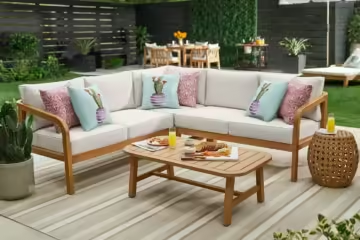Flooring choices range from hex tile for a midcentury modern kitchen to 4-foot faux reclaimed barnwood that can work with both traditional and transitional decor. Some painted wood floors, if treated with a durable finish, can even withstand heavy furniture and kids.
Think about both the aesthetic and functional needs of the room before you choose a material. Harder options, like concrete and stone, aren’t ideal for rooms where you spend long periods of time standing.
Visit Optimal Remodel for top-notch kitchen remodeling services in San Diego. Transform your space with our expert contractors for a stunning kitchen renovation experience.
1. Hardwood
Hardwood floors are a classic and timeless choice. Their beauty adds elegance to a space and they feel warm underfoot. They also complement most design styles and are easy to pair with furniture.
Hardwood is a sustainable option and comes in many different species, cuts, and finishes. It’s durable, long-lasting and easy to maintain with a regular cleaning regimen.
Solid hardwood is crafted from a single piece of wood, making it a sturdy and versatile choice. It’s usually more expensive than other flooring options, but can be refinished and restained to keep it looking new.
Engineered hardwood features a real wood surface over high-quality plywood, which is more resistant to moisture and temperature changes.
2. Tile
Tile floors offer a classic look in countless colors, designs and shapes. Tile can also be found in mosaics and large-format options that create a uniform look with few grout lines.
Consider how you’ll use each room when selecting a flooring material. For rooms where you’ll stand for long periods of time (kitchens and laundry rooms, for example), you’ll want to choose a comfortable yet durable material that is easy to clean and water-resistant.
Tile is an excellent choice, as it’s hygienic and water-resistant. It’s also a good option for homeowners looking to improve indoor air quality and reduce allergies. Choose from glazed, unglazed and polished tile finishes to find the right look for your home remodel.
3. Vinyl
Vinyl is a versatile flooring option that comes in sheet or panel form. It has a waterproof surface designed to resist swelling from moisture, a clear wear layer, and design layers printed to mimic the look of ceramic, stone, or wood floors.
The thickness of the wear layer determines how long the floor lasts. High-traffic areas need a thicker wear layer to stand up well to furniture and foot traffic, while less-used rooms can get away with a thinner one.
Popular brands include Mannington Adura and Distinctive, which offer planks in 6 x 48-inch sizes with micro-bevel “eased” edges, pleasant coloration, and realistic embossing. It’s important to remember, though, that natural light can cause vinyl floors to fade over time.
4. Laminate
Like vinyl, laminate flooring is a multi-layered floor that offers many different wood and stone looks. Its durable nature makes it great for high traffic areas such as busy kitchens and hallways.
A transparent protective wear layer resides on top of a decorative image layer, which allows for high definition reproductions of wood and stone. Below that is a core layer made of compressed high-density fiber board. This is essentially the heart of the flooring sandwich and is resistant to water but not waterproof.
Water-resistant laminate floors are ideal if you have children or pets in your home. Its durability and easy maintenance make it a popular choice for families.
San Diego bathroom remodel by Optimal Remodel offers efficient solutions, optimizing costs and energy with eco-friendly options for glass and window panes.
5. Stone
Natural stone floors add a touch of luxury and sophistication to any home. They are considered one of the best flooring types for resale value and are extremely durable, resisting moisture, heat, and scratching.
It’s important to understand that different stone materials have specific maintenance requirements. Siliceous stones like slate, sandstone and quartzite can take on mild acidic cleaners but calcareous stone (such as marble) needs a more sensitive cleaning process.
Be sure to order enough stone tile for your entire project in one shipment to minimize mismatched pieces. Also, keep in mind that stone floors can be cold to the touch unless you have radiant heating installed.
6. Cork
Cork is a natural insulator, absorbing sound and reducing energy costs. It is also naturally resistant to mold and mildew, and it’s hypoallergenic – good for those who suffer from allergies or asthma.
Cork flooring comes in planks or tiles for installation. It can be painted to match other types of floor materials, and there are a wide range of accessories available. For example, stair nose overlapps are used to blend or transition between floors of different heights and T-molds are great for doorways.
Harvested from the bark of cork oak trees, this environmentally friendly material straddles the line between resilient and engineered flooring. It’s soft and springy underfoot and makes standing for long periods of time easier on backs, knees, and feet.



